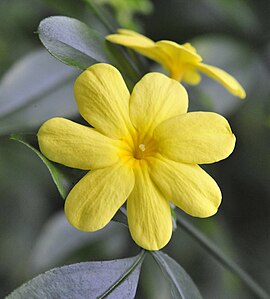Jasminum mesnyi
| Primrose jasmine | |
|---|---|

| |
| Scientific classification | |
| Kingdom: | Plantae |
| Clade: | Tracheophytes |
| Clade: | Angiosperms |
| Clade: | Eudicots |
| Clade: | Asterids |
| Order: | Lamiales |
| Family: | Oleaceae |
| Genus: | Jasminum |
| Species: | J. mesnyi
|
| Binomial name | |
| Jasminum mesnyi | |
| Synonyms[1] | |
|
Jasminum primulinum Hemsl. ex Baker | |
Jasminum mesnyi, the primrose jasmine or Japanese jasmine, is a species of flowering plant in the family Oleaceae, native to Vietnam and southern China (Guizhou, Sichuan, Yunnan). It is also reportedly naturalized in Mexico, Honduras and parts of the southern United States (Florida, Georgia, Alabama, Louisiana, Texas, Arizona).[1][2][3]
Jasminum mesnyi is a scrambling evergreen shrub growing to 3 m (10 ft) tall by 1–2 m (3–7 ft) wide, with fragrant yellow flowers in spring and summer. The form usually found in cultivation has semi-double flowers.[2] It is not frost-hardy. With suitable support it can be grown as a slender climber, though in confined spaces it will require regular pruning.[2][4][5][6]
Jasminum mesnyi has gained the Royal Horticultural Society's Award of Garden Merit.[7][8]
-
Single
-
Semi-double
References
- ^ a b Kew World Checklist of Selected Plant Families, Jasminum mesnyi
- ^ a b c Flora of China v 15 p 311, Jasminum mesnyi
- ^ Biota of North America Program
- ^ RHS A-Z encyclopedia of garden plants. United Kingdom: Dorling Kindersley. 2008. p. 1136. ISBN 1405332964.
- ^ Bob Mitchell (March 2011). "St Andrews Botanic Garden plant of the month - Jasminum mesnyi". St Andrews University. Retrieved 20 May 2013.
- ^ Hance, Henry Fletcher. 1882. Journal of Botany, British and Foreign 20(230): 37
- ^ "RHS Plant Selector - Jasminum mesnyi". Royal Horticultural Society. Retrieved 20 May 2013.
- ^ "AGM Plants - Ornamental" (PDF). Royal Horticultural Society. July 2017. p. 56. Retrieved 14 March 2018.


